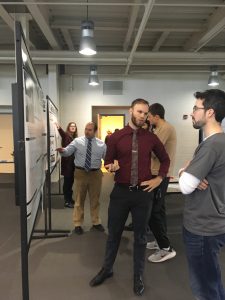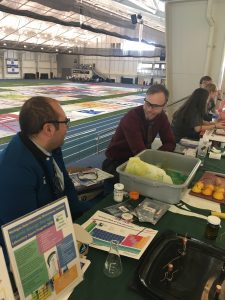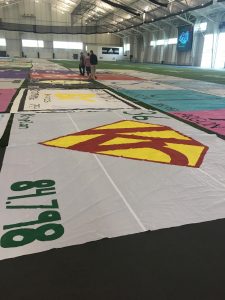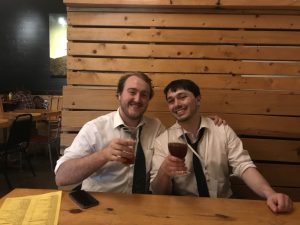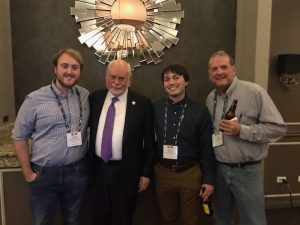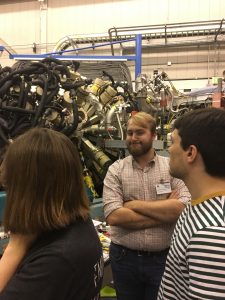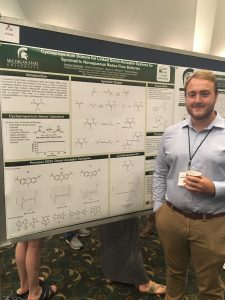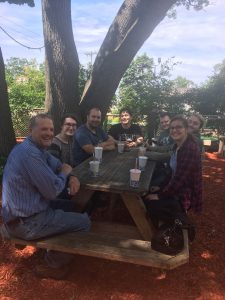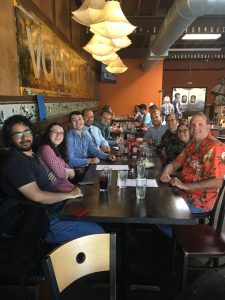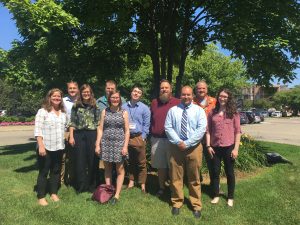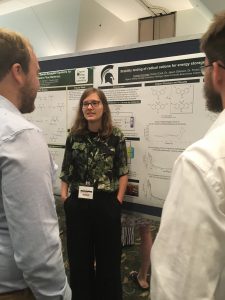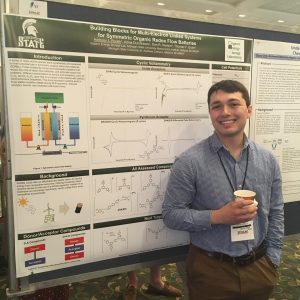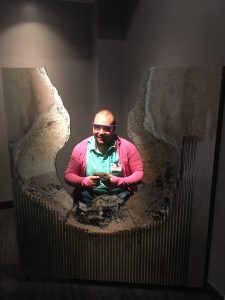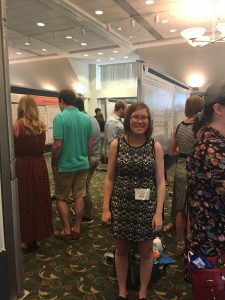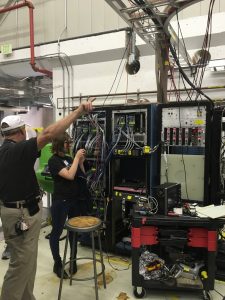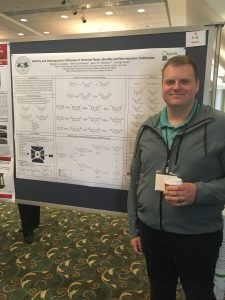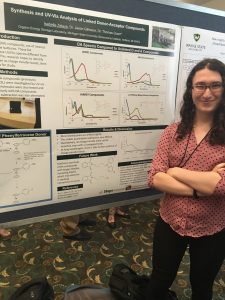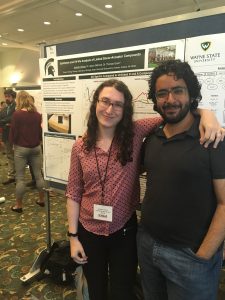The West Michigan Chapter of the American Chemical Society had an amazing event and invited us to take part at Grand Valley State University. They attempted the Guinness World Record for largest periodic table. Many different college and high school groups selected an element and created that portion of the periodic table. We presented posters and hosted an experiment table.
Andrew Rajewski
Andy’s final day with our lab is Friday, October 11. He has been researching with us for more than a year and is relocating to Ann Arbor to work for PIDC doing Research and Development for them. He is also planning on continuing to grad school next year.
Andy has become a fantastic “synthesizer” over his year with us. He has presented a talk at ECS in Dallas and presented posters at ACS Great Lakes and the Hope College Schaap Symposium. He has advanced our understanding of donor/acceptor compounds for organic redox flow batteries. But more importantly, he is a fun addition to our lab and we will miss his smile. “Cheers” to your future Andy!
Summer 2019 Wrap-up
Thanks for a great summer and another great intern group!
After tours, poster sessions, a lot of research and a lot of ice cream, we got some good feedback for next year. It is good to know that everyone that filled out the evaluation form would recommend the MSUBI Summer Intern program to others. Below are some other comments we received…
What I liked most? Doing actual relevant science! and working with projects where I have some control over the direction, priorities and techniques… I liked having ownership of a project, in the sense that I had to decide what direction to go in and had some guidance but also the chance to pursue avenues that caught my eye…. I liked the opportunity to work towards something with a real-life application that’s realistic and impactful.
Were expectations reasonable? Yes, I think that like any research position progress isn’t always linear, but clear goals were set and progress was reported while suggestions were given to help toward those goals.
Was the project interesting? Yes, it allowed me to expand my scientific knowledge by doing some inorganic synthesis and learning new electrochemical techniques.
Was the experience valuable? Absolutely!
Kassia Symstad
The final poster highlighted is Kassia’s…
Stability testing of radical cations for energy storage applications.
Kassia Symstad, Dr. Thomas F. Guarr
Electron donor molecules must be stable in both the neutral and radical cation form to be viable as shuttles for overcharge protection in lithium ion batteries or as part of a larger donor-acceptor system for use in redox flow batteries. In this work we report stability testing on a variety of carbazole and phenothiazine-5,5-dioxide derivatives. Conversion of the neutral molecule to its radical cation state was accomplished either by chemical oxidation or electrolysis in a spectroelectrochemical cell. The radical cations of these donor molecules have a differect UV-vis spectra than the neutral molecules, which provides an effective means to monitor their generation and persistence. The voltage that resulted in the maximum rate of conversion to the radical cation form was found this way. that voltage was them applied for a longer period of time, either in a spectroelectrochemical cell or a conventional H-cell for bulk electrolysis to effect complete conversion. This allows the radical cation to be studied on time scales ranging from seconds to months. These stability studies are useful for the evaluation of preliminary data from a linked donor-acceptor system in a prototype RFB cell.
Anthony Porath
We had a total of seven posters presented at the Schaap Symposium. Our next presenter is Anthony Porath…
Building blocks for multi-electron linked systems for organic redox flow batteries
Anthony Porath, Adina Dumitrascu, Dan Henton, Jason G. Gillmore, Thomas F. Guarr
A series of redox-active compounds were synthesized and electrochemically assessed for their potential use in nonaqueous redox flow batteries (RFBs). These include electron donating species, the donors, and electron accepting species, the acceptors. The donor and acceptor moieties are separated with an expensive ion-exchange membrane in traditional RFBs, but when covalently-linked a simple separator is able to be utilized. The donor/acceptor systems exist in three stable oxidation states during RFB operation: reduced (anolyte), neutral, and oxidized (catholyte) forms. The pursuit of multi-electron redox-active species would serve to further lower costs. Decreasing the cost as much as possible is important as it would make it much more economical to introduce RFBs in a large-scale grid storage role. The synthesis, characterization and preliminary electrochemical investigation of these molecules will be described.
Andrew Rajewski
Andy also presented a poster at the Schaap Symposium…
Cyclopropenium Donors for Linked Donor-Acceptor Systems for Symmetric Nonaqueous Redox Flow Batteries
Andrew Rajewski, Adina Dumitrascu, Jason G. Gillmore, Thomas F. Guarr
A series of molecules containing electron donor (D) and electron acceptor (A) moieties are being explored for future use in symmetric organic redox flow batteries (RFBs). The synthesis, characterization and preliminary electrochemical investigation of these molecules will be described. Past studies in the group have looked at heterocyclic donors. This work focuses on the synthesis of cyclopropenium donors for use in linked donor-acceptor systems. Cyclopropenium donors have been studied in recent years and have shown promising properties for use in RFBs (>=0.8 V vs. Fc/Fc+, <3% loss of storage capacity over 200 cycles).) Linking these donors to acceptors in linked systems allows for a symmetric RFB that eliminates the ubiquitous and expensive ion exchange membrane used in typical RFBs. Because the membrane can account for up to 40% of cell costs, this could represent an important opportunity to improve the economics of employing flow batteries for grid-level energy storage applications.
- Sanford, Adv. Energy Mater., 2016 7(5), 1602027
Michael Giuirini
Mike will be finishing up his engineering degree at Hope College this fall and continuing his work with us throughout the year. He joined us this summer to work on supercapacitor applications.
Nickel (II) and Copper (II) tetraaminophthalocyanines for Supercapacitor Applications
Michael T Giurini, Kevin Klunder, Thomas F. Guarr
As the world embraces renewable energy sources and moves away from fossil fuels, the demand for efficient ways to store energy has increased substantially. Supercapacitors can be used to enhance energy efficiency. While they store less energy than batteries, they can absorb and release it at a much faster rate. Conductive polymers produced from nickel, copper, and cobalt tetraaminophthalocyanines can be used to fabricate electrochemical double layer capacitors (EDLC) with unique electric storage properties. Using cyclic voltammetry, these compounds can be electropolymerized to form thin films, which can then be conditioned with an annealing process to act as EDLC’s. Studies to determine the optimal conditions for electropolymerization and conditioning will be reported. The polymerization and annealing process was tested with various electrolytes, solvents, and electrode surfaces. Resulting polymer films were analyzed electrochemically and by scanning electron microscopy (SEM) to determine the impact of these variables on EDLC formation.
Tara Vogel
Tara is returning after a successful summer at OESL and Jolt Energy to the University of Chicago to finish up her Physics degree. We are very happy Tara was flexible enough to agree to work for Jolt Energy and collaborate with the OESLab during her summer here. She was greatly instrumental in setting up and controlling the latest prototype flow battery.
Due to scheduling and disclosure issues, she was not able to present a poster this summer, but she did participate in the Schaap Symposium with us and we really enjoyed her time with us.
Zach Lincoln
Zach joined us for the summer after graduating from Alma College. He is studying for his PhD in Inorganic Chemistry at Notre Dame University this fall.
Stability and Decomposition Pathways of Potential Redox Shuttles and Non-aqueous Catholytes
Zachary S. Lincoln, Adina Dumitrascu, Jason G. Gillmore, Thomas F. Guarr
The Organic Energy Storage Laboratory has prepared a variety of carbazole and phenothiazine derivatives as potential catholytes for non-aqueous redox flow batteries and as redox shuttles for lithium ion batteries. Their stabilities, beyond reversible voltammograms, has not been assessed; nor have their potential decomposition pathways. Using Ion-Trap Mass Spectrometry (ITMS), the decomposition of these compounds can be investigated. Additionally, deuterium-labelled analogs were prepared and characterized by GC-MS, 1H and 13C NMR, and ITMS to confirm the decomposition pathways observed in protio derivatives.
It was a great summer, Zach. Thanks for spending it with us and best wishes for your experience at Notre Dame.
Isabelle Zelaya
Isabelle Zelaya joined us this summer from the University of Michigan. She is starting her senior undergraduate year this fall studying Chemistry. Izzy’s curiosity was a pleasure to have in the lab.
Synthesis and UV/Vis Analysis of Linked Donor-Acceptor Compounds
Isabele Zelaya, Dr. Thomas F. Guarr
Our group has prepared a variety of molecules containing electron donors covalently linked to electron acceptors (DA compounds) for redox flow battery applications. Beyond their use in energy storage, these DA compounds were expected to have interesting spectroscopic properties. It was expected that photoinduced electron transfer from the donor to the acceptor would produce spectroscopic peaks not present in the isolated donor and acceptor compounds. By comparing the UV-Vis spectra of the individual donors and acceptors to the DA compounds, it is theoretically possible to subtract out the signature of the donor and acceptor, leaving only this charge transfer band. Such bands have proven elusive in molecules with flexible, saturated linkers, which have been the most widely investigated type. The synthesis and study of some systems with more rigid, conjugated linkers will also be presented. Systems with longer flexible saturated linkers, which may allow pi-pi interaction between donor and acceptor groups, are also proposed.
Thanks for spending the summer with us, Izzy. Enjoy your senior year and keep in touch. We are curious to see what your future holds.
